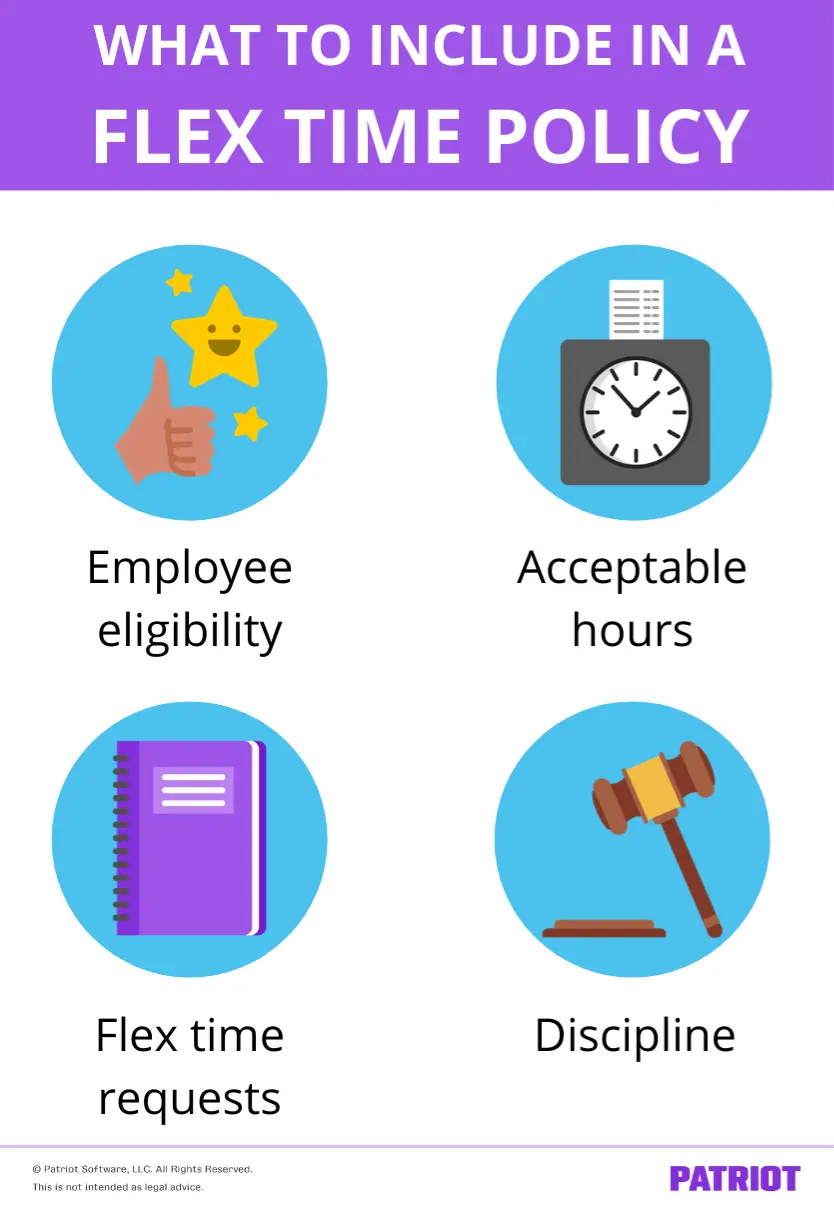As workplaces evolve, work arrangements are changing, too. Employees across the country are saying goodbye to the standard 9 to 5 shift and hello to remote work and flexible schedules.
One work arrangement that’s making its way into workplaces is flex time. To help decrease absenteeism and better fit your employees’ scheduling needs, consider creating a flex time policy for your company.
What is flex time?
Flex time, flextime, or flexible time, is a schedule that allows employees to change the start and end times of their workday(s). With flextime, an employee can adjust their schedule based on life events (e.g., doctor’s appointment).
Flextime is 100% up to the employer. There are no set time frames that flex time must cover or include. And, employers aren’t legally obligated to offer flextime to workers. This means employers are responsible for determining their business’s flextime arrangements (e.g., hours). Here are a few examples of a flextime work schedule:
- 11 a.m. – 4 p.m., flex, 5:30 p.m. – 8:30 p.m.
- 6 a.m. – 10 a.m., flex, 12 p.m. – 4 p.m.
- 9 a.m. – 1 p.m., flex, 3 p.m. – 5 p.m.
- 7:30 a.m. – 3:30 p.m.
Although any business can offer flex time hours to employees, a flextime plan works best in certain industries (e.g., information technology). Businesses that operate 24-hours per day and need staff both day and night typically benefit from a flextime system.
What does a flex time policy include?
There are a number of things you have to think about when you’re creating your flex time policy. Which employees are able to use flex time? Should employees be available during certain hours of the day? What kinds of guidelines will you have in place?
After you finish breaking down what you plan on including in your flex time work policy, you can begin building it. Keep in mind that no two flextime policies are the same. Policies can vary from business to business and depend on your employees and industry.
Some of the most common sections that businesses include in their flextime policies are:
- Employee eligibility
- Acceptable hours
- Flextime requests
- Discipline
Employee eligibility
Depending on your type of business, not every employee is a good fit for your flex time policy. For example, a flex time policy may not line up will for an employee who works with customers or clients directly.
Consider which employees can be eligible for flextime at your company. Outline what positions (e.g., IT) and types of employment (e.g., full-time workers) are eligible for flextime in your policy. And, outline the roles that cannot take advantage of flex time.
In your policy, you should also specify what makes certain employees eligible for flextime, such as a solid attendance record and good workplace performance.
Acceptable hours
Many businesses with flex time policies have a section that details acceptable hours for employees. This section acts as a guideline for employees when they request or use flextime.
In this portion of your policy, include information about:
- The number of hours employees have to work per day/week (e.g., 40 hours per week)
- Acceptable hours/bandwidth (e.g., an employee can work anytime between 6 a.m. and 7 p.m.)
- Consistency of hours (e.g., working the same flextime hours every day)
- Lunches and breaks
This section should clarify what is and is not acceptable for flexible working hours. Break down as much information about hours as possible to avoid any confusion.
You may consider also including “core hours” for your employees to follow in this section. Core hours are times all flextime employees must work to help increase collaboration. For example, you might require all flextime workers to work from 11 a.m. – 1 p.m. in case you need to have a meeting.
Flextime requests
If you plan on having employees submit requests to use flextime, include a section for it.
Your flextime requests section should include details about:
- When employees can submit their request
- How employees submit their flextime request
- Who the request should be given to (e.g., manager)
- Turnaround time for reviewing employee requests
If you want employees to fill out a form for their flextime request, be sure to include where they can access the form.
Discipline
If an employee breaks any rules pertaining to your flextime policy, lay out the consequences in this section. Include whether they get “warnings” or “strikes” for certain situations.
For example, you may give an employee a warning if they don’t work during your core hours one day. But, you may give an employee a strike if you catch them taking advantage of flextime and not working during their flextime hours.
If you plan on requiring employees to have a trial or probationary period for flex time, also include details about it in this section (e.g., two-week probation period).

Tips for implementing flextime
When it comes to implementing a flex time policy, you must keep a few things in mind. You need to:
- Think about which employees you will offer flex time to
- Spell out your policy in your employee handbook
- Be clear about your expectations
- Set up consequences if flex time rules are broken
The more you include in your policy about flex time, the better off your business will be. Be sure your policy is thorough and consistent. That way, employees know your expectations and have a crystal clear understanding of how the flextime process works.
Benefits of flextime for employees and employers
A SHRM study found that 80% of employers saw an increase in employee engagement and morale after offering flexible work arrangements.
A flex time policy is a win-win for employees and employers alike. With a flextime program, employees can enjoy an improved work-life balance for things like going to school, picking up or dropping off their kids, and going to appointments.
And, a flextime policy can give your employer brand a boost, increase employee satisfaction, and improve productivity.
After creating your flex time policy, make sure your employees can read it! Patriot’s HR Software add-on to our payroll software makes it easy for employees to access important files online. Start your free trial today!
Have questions, comments, or concerns about this post? Like us on Facebook, and let’s get talking!
This is not intended as legal advice; for more information, please click here.






